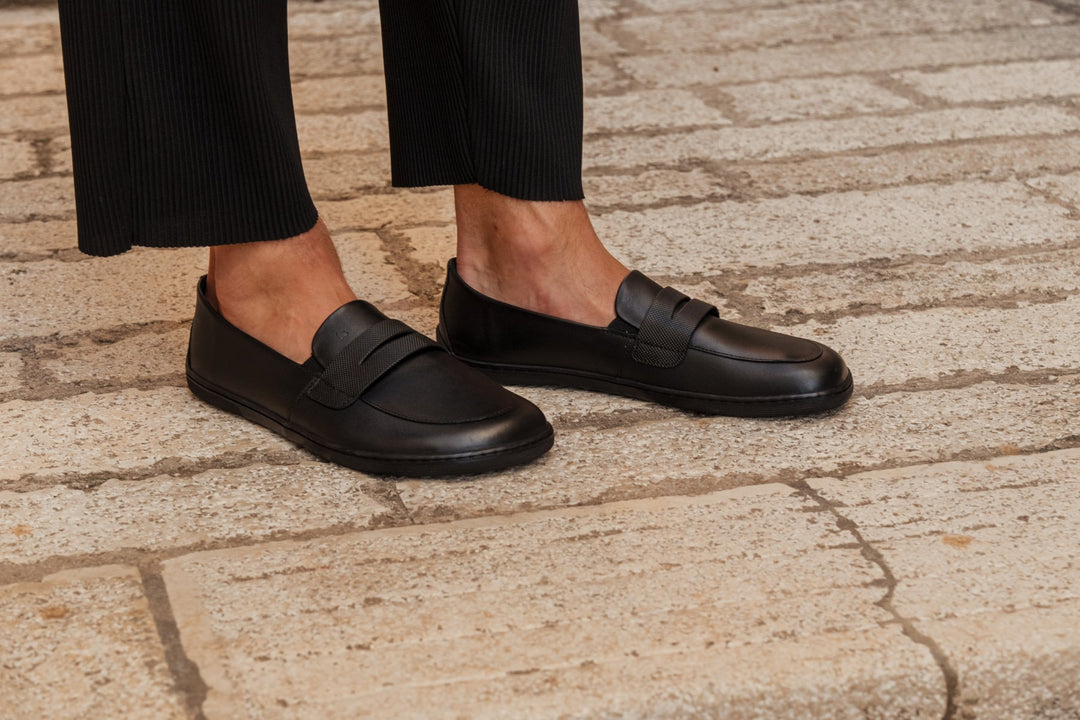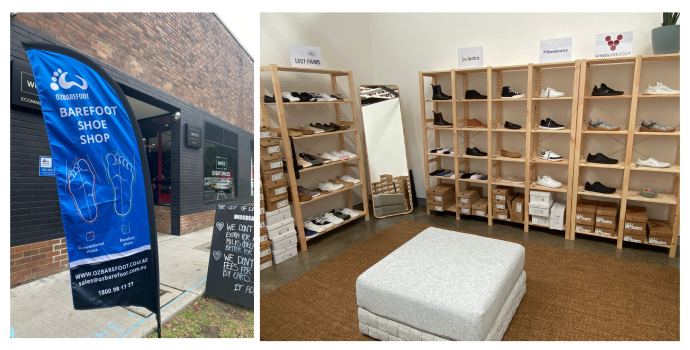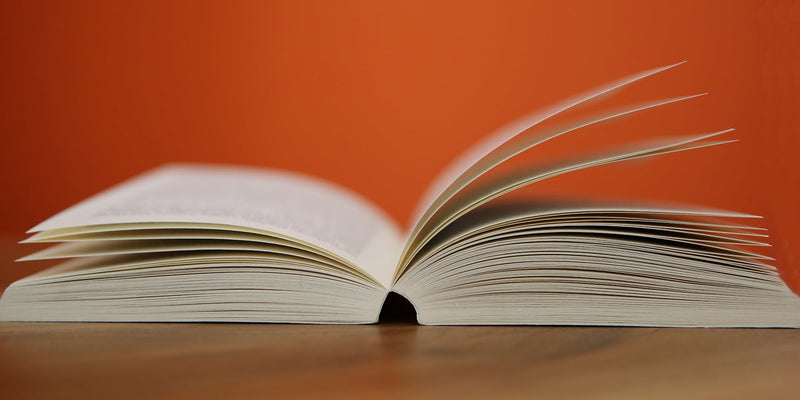Barefoot shoes are growing in popularity amongst athletes and everyday folks alike. They're touted as a revolutionary approach to improve foot health, whole-body posture, and athletic performance.
They can be helpful for runners, weightlifters, crossfitters, or simply anyone wanting to improve their foot health by switching to casual wear barefoot shoes.
We've collected some compelling evidence to help you decide whether barefoot shoes health benefits are worth the hype or not.
Understanding Barefoot Shoes and Their Benefits
So what makes a barefoot shoe stand out from regular shoes? As you might imagine, the idea is to give feet the space and mobility to function as they do without shoes.
Though you won't feel as if you're barefoot exactly, your feet will feel significantly more light and free in minimalist barefoot shoes compared to conventional shoes.
According to the study in the journal Medicine and Science in Sports and Exercise, the average adult in Western Australia walks 9695 steps a day or 7.76 km. Sounds like a great reason to invest in your foot health!
Barefoot Shoes vs Regular Shoes: Key Differences and Their Impact on Foot Health
Here are the basic factors that separate barefoot shoes from their regular counterparts:
|
|
Barefoot Shoes |
Regular Shoes |
|---|---|---|
|
Toe Box Width |
Wide toe box to allow for natural toe spread |
Narrow toe box that restricts movement |
|
Sole Thickness |
Thin sole (<6mm) to increase underfoot sensations* |
Thick to very thick sole to provide comfortable cushioning |
|
Flexibility |
Made of extremely flexible materials to optimize foot mobility |
Made of moderately rigid to very rigid materials that limit movement |
|
Ankle + Arch Support |
Little to no ankle or arch support to increase natural foot stability |
Little to high ankle support and high arch support to reduce risk of ankle collapse and flat feet* |
|
Weight |
Extremely lightweight |
Moderate to heavy in comparison to barefoot shoes |
|
Heel Elevation |
Toes and heel are level (zero drop) |
Heel is elevated above toes with cushioning |
These differences might seem arbitrary at first glance, but we can guarantee they're not.
Each feature has been developed with foot health in mind, and since feet are the foundation of the body, the impacts spread throughout the rest of the body as well.
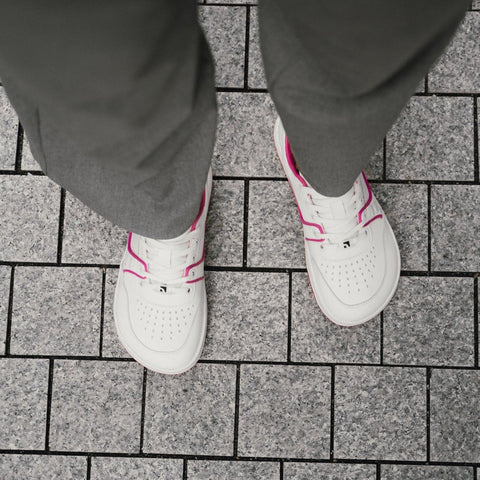
You can find more about differences in our article: Barefoot Shoes vs Regular Shoes: The Essential Differences
Less Support and Cushioning = Stronger Feet in the Future
Barefoot shoes notably provide much less support and cushioning than regular shoes. The purpose behind this is to allow feet to adapt and become stronger.
The support and cushioning of regular shoes might be more comfortable in the short-term, but it has downsides in the long-term.
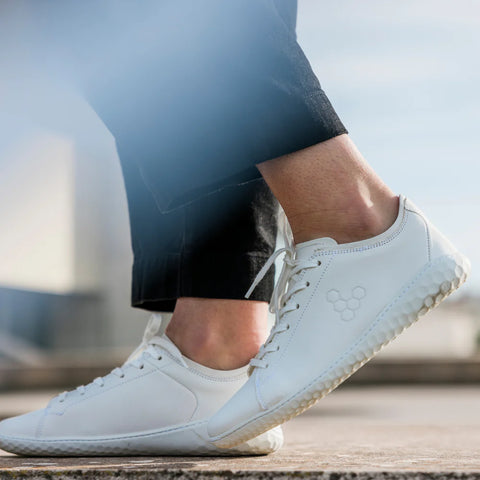
Since the shoe is doing all the work of holding your arches up and ankle in place, you'll start to lose strength in these areas and become reliant on highly supportive shoes.
Walking without shoes could start to become painful and you'll be at higher risk of injuring yourself in these weakened areas.
Higher mobility and perfect freedom of movement
The other major difference between barefoot shoes health benefits and regular shoes is the amount of movement they allow your feet to have inside the shoe.
Regular shoes often cram the toes together which means you have a limited capacity to use your toes for proper balance.
Unfortunately, the old adage of "use it or lose it" applies in this case as shown by studies on the decreasing mobility of seniors. The less you utilize your toes in day-to-day life, the less mobile and strong they'll be.
The Long-Term Payoff
All of this is to say that though the transition to minimalist shoes may not be seamless and as comfortable as you'd hope, the payoff is more than worth it.
Did you know tight fitting shoes are one of the major causes of ingrown toenails? Luckily, barefoot shoes won't ever give you this problem.
Health benefits of wearing barefoot shoes
These are the specific health benefits you'll reap from making the jump:
1) Increased Ankle and Toe Mobility
Ankle and toe mobility has been shown to be incredibly important for athletic performance and everyday foot health by several studies. The raised heel of regular shoes puts the ankle in an extended position and shortens the calf muscle.
Over time, this reduces the flexibility of the ankle and impedes movement into a flexed position (dorsiflexion) which decreases your ability to bend down in a squat position, jump, and run.
Barefoot shoes avoid this problem with their zero drop heel height.
Toe mobility will also become limited with regular use of conventional shoes.
Toes should be able to naturally splay out when barefoot to improve balance, adapt to direction changes, and increase pushing power in athletic movements such as jumping and sprinting.
Barefoot shoes have enough room in the toe box to account for this healthy toespread which is otherwise impaired by regular shoes.

Another important facet of toe mobility is the ability to flex the toes upward.
This is possible in barefoot shoes because of their flexible light-weight fabric, but nearly impossible in rigid regular shoes.
Read more: 5 Reasons Why You Should Try Zero Drop Shoes
2) Stronger Toes, Feet and Ankles
The feet and ankles contain 29 small muscles that allow them to move in a multitude of ways.
They're one of the most skeletally complex areas of the body!
This is because they need to be strong and durable to carry around our full weight all day. Barefoot shoes can increase the strength of all these small muscles of the foot and ankle since they don't offer the same structure as a conventional sneaker.
This means you'll have to rely on your own strength to keep your ankles upright during movements and push off from your toes instead of relying on the spring cushioning of running shoes.
This might make certain movements feel more tiring for a time as your body adjusts to building and using its own strength.
Read more: Are Barefoot Shoes Good For Running?
3) Better Balance
Another barefoot shoes health benefit not to be overlooked is the vast increase in balance you'll see from regular barefoot shoe use.
Balance is a complicated process that involves sensory processing from the foot to determine details about the surface you're on, as well as visual cues and the mental capacity to map out where your body is in space.
This is called proprioception which we'll touch on shortly.
In addition to receiving these information outputs, your body has to be able to outwardly adapt to find balance.
You'll need good control of the small muscles in your feet, toes and ankles.
This control comes from mobility, strength, and neuromuscular connection, all of which are developed when opting for barefoot shoes over regular ones.
4) Increased Proprioception
As we mention, proprioception is your ability to determine where your body is in relation to your environment.
What this looks like in practice is being able to catch a ball that's thrown at you, or step onto a wobbly rock without falling. It makes you more in control of your body.
Current science shows that barefoot shoes can improve proprioception by increasing sensory environmental feedback.
When you step on a pebble in barefoot shoes, you'll be able to feel it through the thin soles and react in a more natural way.
You'll be more inclined to watch your footing to keep yourself safe and develop the skills you need to navigate tricky terrain.
5) Decreased Joint Stress
This next barefoot shoes health benefit might not seem very exciting to a young person with healthy joints, but the joints of the knees and hips are often exposed to a significant amount of stress which overtime eventually leads to fragility and injuries.
Evidence shows that the most common cause of this is an improper foot striking pattern.
When most people walk or run, they land heel first with a straight leg and a heavy thud. This doesn't hurt if you're wearing thick soled cushiony shoes, but it still causes stress on the joints.
Barefoot shoes help mitigate this problem by changing the foot strike pattern.
Since barefoot shoes are very thin soled, it won't be comfortable to stomp around on your heels!
You'll naturally adapt to landing on the midfoot or even the toes which provides innate healthy rebounding from the muscles of the foot.
This will increase the strength of these small muscles and soften the impact from walking and running on your joints. Your body was designed to move barefoot and contains all the proper engineering to do so.
The issue of heel striking is a modern problem that only arrived because of the invention of the restrictive and heavily padded shoe.
6) Improved Posture and Less Back Pain
You may not realize this, but your feet play a huge role in your presence or lack of back pain. This is because they're the base of your posterior chain, which your back is a part of.
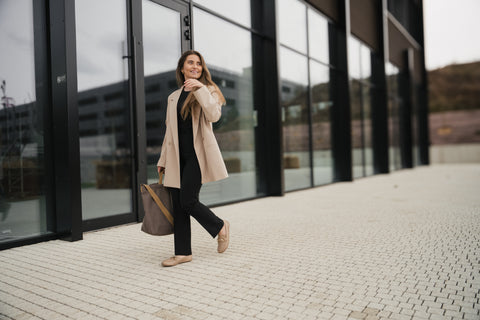
Issues tend to arise when the heels are elevated, because it shifts your center of gravity forward. Your body adapts to this by tilting the pelvis forward and increasing the curvature of the lumbar spine.
This shortens the muscles of the back and can cause them to become tight and seized. An extreme example to see this in action is the visible posture change that occurs when women wear high heels.
This cause the back to go into kyphosis (a highly curved position) and causes back pain if they're worn for any length of time.
Regular shoes are a less pronounced but still concerning example of this since they almost always have an elevated heel.
Barefoot shoes are completely level between the heel and the toes which keeps the spine in its proper position and the back pain free.
7) Prevents Bunions
Another issue seen time and time again from conventional shoes is the development of bunions.
Bunions are bone deformities that form in response to pressure on the sides on the feet from tight fitting shoes.
They usually occur at the joints of the big toes and the pinky toes which makes rigid shoes increasingly uncomfortable.
Since barefoot shoes are made of flexible materials these problems won't occur, and they can also be a more comfortable alternative to regular shoes if bunions are already present.
It's important to note however that barefoot shoes can't reverse bunions.
8) Stronger Connection to Nature
A final barefoot shoes health benefit that might seem woo-woo at first glance but actually has solid reasoning behind it is an increased connection to nature, which can improve mental health and emotional wellbeing.

It's been shown that being in nature and interacting with nature can improve mood and increase physical health.
This experience is heightened in barefoot shoes since your brain will be receiving far more sensory information about your environment through their thin soles than you would with regular shoes.
The more immersive an experience is, the more impactful it is.
You can think of the stark difference between walking on foot to experience a new place versus the more removed sensation of driving through in a car as an example of this.
Barefoot shoes will bring you closer to your natural movement as well as physically closer to the nature around you.
Want to know a few of the best ways to relieve sore aching feet? Elevate them, soak them in warm water, or massage them.
How to Transition to Barefoot Shoes: Not Always Easy But Worth It
If you're on board with the barefoot shoe idea, it's still important to make the shift wisely.
If your foot is lacking the strength and mobility necessary for your daily activities, jumping in too fast may cause more harm than good by asking more than your small foot muscles are ready for at the moment.
Here are a few tips to ease in without injury:
- Start slow and work up to wearing barefoot shoes more often.
- Begin with casual wear barefoot shoes but continue to wear your usual footwear during exercise until your feet gain more strength.
- Opt for a shoe that offers some barefoot shoes health benefits with some of the comforts of regular shoes as a beginner-friendly option.
- Be barefoot more often to further help improve foot strength and mobility.
- Try adding some foot strength and mobility work to your routine.
Read more: How to transition to Barefoot Shoes?
Precautions
Though barefoot shoes are a great option for many, it's important to note that they're not for everyone.
If you are experiencing pain from wearing barefoot shoes you should take a break and consult a healthcare practitioner.
It's also not a recommended practice for those who lack sensation in their feet (such as diabetic neuropathy), those with hypermobility, musculoskeletal deformities or chronic pre-existing foot conditions.
Final Thoughts
If you believe barefoot shoes can play a role in improving your foot health, don't hesitate to give them a try.
Your feet play an incredibly essential part in full-body health and mobility, and it's never too early to instill good movement patterns. Browse our wide selection of styles to find a pair that fits perfectly with your individual lifestyle.
Sources
- Pedometer-Measured Physical Activity and Health Behaviors in U.S. Adults
- The effect of walking on fitness, fatness and resting blood pressure: a meta-analysis of randomised, controlled trials
- The Importance of the Foot and Ankle in Athletic Performance
- What is proprioception?
- Anatomy, Bony Pelvis and Lower Limb, Foot
- Proprioception
- What We Can Learn About Running from Barefoot Cultures
- Running Barefoot or in Minimalist Shoes: Evidence or Conjecture?
- Reflex Activation of Gluteal Muscles in Walking
- Health benefits of Be Lenka barefoot shoes




